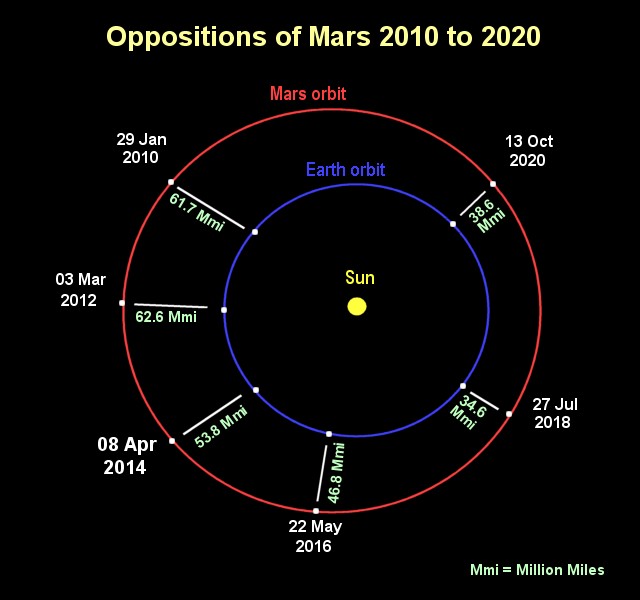Mars' orbit (a = 1.52 AU) is considerably more eccentric
than Earth's, with e = 0.0934.
Thus, its opposition distance from Earth can change by 0.28 AU, or 42 million
km. Thus, some oppositions are far better than others for observing
the planet up close. Mars has seasons similar to Earth's, due to
its spin axis inclination of 25o12',
and its day is also similar to Earth's, with sidereal rate 24h 37m 22s long. Mars has two tiny moons, Deimos and Phobos, which are likely
captured asteroids. We will discuss these in more detail when we
discuss planetary moons, but note that the inner-most moon, Phobos, is
so low that it is only just outside the Roche limit for its destruction.
 |
| Oppositions of Mars through 2020. |
Mars' radius is 3394 km,
or 53% of Earth's radius. That makes its volume (0.53)3 = 15% of Earth. Its mass, however, is only 11% of Earth's mass, so
its bulk density is about 3930 kg/m3.
This is considerably less dense than Earth (5500 kg/m3)
and only slightly denser than the Moon (3300 kg/m3).
Since the crust and mantle of Mars is probably the same as Earth, this
argues for a smaller relative size for the iron core.
Here is a comparison of the
cores of the terrestrial planets and the Moon. Each wedge shows the
relative scale of the indicated body and the proportion of mantle and core.
Mars' core is a smaller fraction of its volume than the other terrestrial
planets, while Mercury's core is the largest fraction of its volume.

(from http://quartz.ucdavis.edu/~gel36/comparison.html)
Mars' atmosphere
is far thinner than Earth's, yet it still supports high winds and clouds
of both carbon dioxide and water, and it can form a frost of carbon dioxide
ice on the ground. The atmosphere is 95% carbon dioxide (CO2),
a few percent nitrogen (N2) and argon (Ar),
and only 0.1-0.4% oxygen (O2). If
you took all of the water out of the atmosphere at once and deposited it
in a layer on the ground, it would only be 0.01 mm deep. On Earth
the equivalent number is typically several cm.
The albedo of Mars is quite
low, at 0.15, and its perihelion distance from the Sun (~1.38 AU) gives
a peak subsolar temperature of
Tss =
394 (1-A)1/4
(rp)-1/2
= 394 (0.96) (1.38)-1/2
= 322 K (at perihelion).
This is close to the highest
observed summer temperature of about 310 K, which corresponds to a quite
hot 37 C, or 99 F. However, Mars is a rapid rotator, so we should
use the equilibrium temperature equation. Also, if we use the typical
distance of the semi-major axis of Mars' orbit, 1.52 AU, we get:
Teq =
279 (1-A)1/4
(rp)-1/2
= 279 (0.96) (1.52)-1/2
= 217 K (typical average).
This is -56 C, very cold indeed.
And of course the day-night variation of this temperature can be +/- 50
C.
Likely we know more about
Mars than any other planet besides Earth. This is due to the many
missions to Mars, and the fact that Mars, unlike Venus, has a thin transparent
atmosphere that allows us to see the surface.
Missions:

